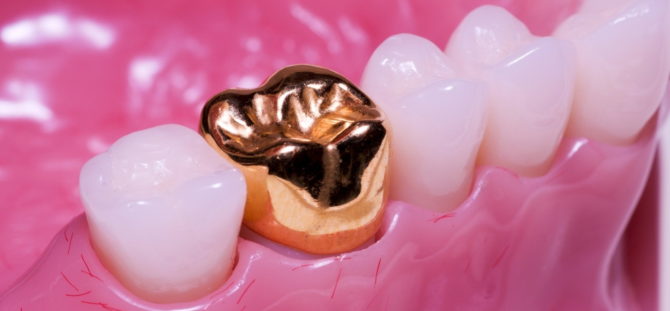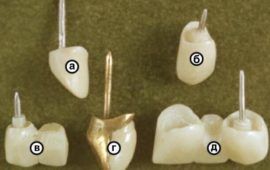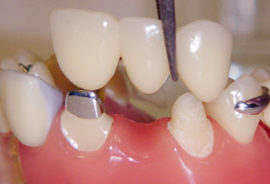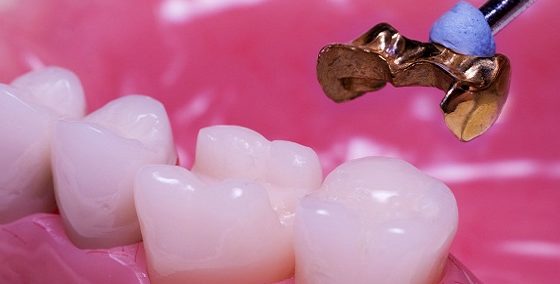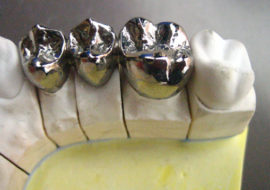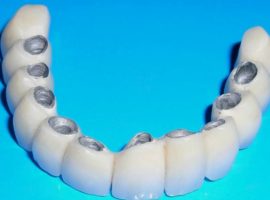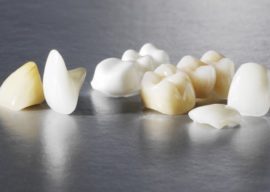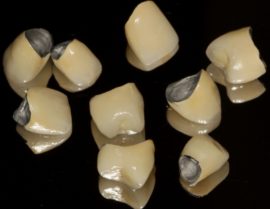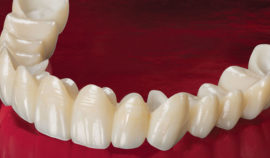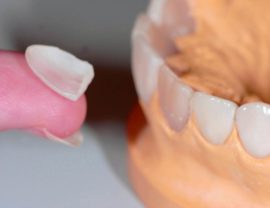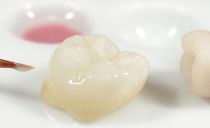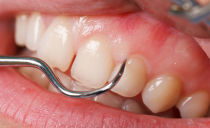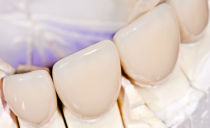Types of crowns on teeth, which crowns are best placed on the front and chewing teeth
With age, the dentition of people becomes incomplete, various reasons are to blame: dental diseases, injuries, heredity. Over time, everyone has to look for ways to restore it, so as not to suffer from imperfections in the masticatory function, speech and smile aesthetics. In such cases, people turn to dentists with questions about the types of modern crowns and which ones are best placed on certain teeth.
Content
What teeth put crowns
A crown is a prosthesis that can replace a tooth in whole or in part. In the first case, the crown is mounted on a pin that replaces the root. In the second, the prosthesis is placed on a dilapidated tooth with a whole root.
Indications for such prosthetics are:
- Complete lack of tooth.
- The destruction of the crown by half or more.
- The active process of destruction of the natural crown due to the rapid abrasion of hard tissues.
- The presence of visual defects on enamel that cannot be eliminated by other methods: fluorosis damage, advanced cases of tetracycline teeth.
A crown is placed on any tooth, but the type of prosthetic product depends on the location of the lost dental unit: durable but less aesthetic ones are used for restoration of chewing molars, the most aesthetic ones are for front incisors and canines. If the prosthesis is placed on the existing residue of the natural crown, the dentist will first cure the tooth from caries, then fill it and grind it to achieve a perfect fit of the prosthetic structure.
If several units in a row are absent in the dentition, they can be replaced not with individual prostheses, but with bridge-connected ones. Such complex designs must rely either on crowns mounted on adjacent healthy teeth, or on artificial prostheses that are held in the gum by pins.
In addition to whole crowns, there are half crowns that restore only those parts of the tooth that have been destroyed.
Types of crowns with low aesthetic qualities
In dentistry, equipped with modern equipment and materials, the patient can be offered a wide selection of prosthetics methods. Each type of prosthesis has its pros and cons. This table describes not the best aesthetic crowns for front and rear teeth, the use of which is justified only in extreme cases.
| Types of crowns | pros | Minuses |
|---|---|---|
|
Metal crowns |
|
|
|
Metal-plastic crowns |
|
|
|
Plastic dentures |
Very cheap. | The same disadvantages as for metal-plastic prostheses. Plus, plastic products are very fragile, therefore they are used only for temporary prosthetics. |
The most aesthetic types of crowns
The following varieties of crowns have the highest aesthetic indicators and have more pros than cons.
|
Ceramic-metal crowns |
|
|
|
Metal-free ceramic crowns |
|
|
The best types of chewing crowns
Chewing teeth are called the posterior units of the dentition - molars and premolars. Their common feature is a massive shape with an almost flat but notched surface. This is due to their purpose - grinding, chewing food. They almost never fall into the smile line, therefore there is no urgent need for a high esthetics of prostheses. The types of crowns that can be placed on chewing teeth must be strong and reliable.
If you ask the dentist which crown is best to put on chewing teeth, he will recommend the following options:
- Metal. Despite the low aesthetics, it copes with the load perfectly, and for many years. To avoid the occurrence of a galvanic effect, you must always put crowns of the same metal. If they are different, a weak electric current will appear between them.
- Cermet. Much better than iron crowns, metal-ceramic prostheses look. If the patient is unlimited in finances, he can afford to restore even chewing teeth without losing aesthetics. If the choice fell on cermets, you need to ask your dentist what kind of crown is better to put. The best characteristics are possessed by products with a frame made of precious metal alloys and metal made by milling. The former do not react with the environment of the oral cavity and look quite natural. The second fit as accurately as possible to the neck of the tooth.
- Zirconium. Zirconium crowns have a very high cost, but they are better than cermet both in strength and aesthetic qualities.
If you need to insert a pin to restore a tooth with an increased load, it is better to give preference to a titanium product, since it is stronger than fiberglass. For restoration of the front teeth, titanium pins are not suitable, since they can be visible through the tooth surface.
What are the crowns on the front teeth
Front teeth provide pronunciation of many sounds and perform their direct function - biting off pieces of food. But the main thing is that they are located in the visible part of the dentition.Therefore, when deciding which crowns are the best for installation on the front teeth, preference is given to those prostheses that look the most aesthetically pleasing:
- Cermet. Cermets are the “golden mean” between cheap and unaesthetic iron prostheses and too expensive, but very high-quality non-metal alternative.
- Metalless porcelain and zirconium. An acceptable option for wealthy patients whose main requirement is a high aesthetics of the appearance of the dentition.
- Metal-plastic. A cheap, but very unreliable option, which can ensure the attractiveness of the dentition only for a short time.
- Plastic. Cheap prostheses, installed only on time. The manufacture of ceramic-metal or ceramic prostheses is a lengthy process. Therefore, the turned-out tooth residue is covered by a cheap but fragile alternative from plastic with a short service life.
If a person does not have the means, but he has problems with the dentition, the only acceptable option for him is iron prostheses. Cheap plastic constructions in this case will not help, because they quickly deteriorate, and they need to be reinserted, which again entails financial costs.
Alternative to crowns - microprostheses
Sometimes, when searching for the best dental crowns, patients come to the conclusion that this option of prosthetics is not suitable for them. The restoration of practically whole teeth with minor surface defects can be accomplished by micro-prosthetics. There are two types of micro prostheses:
-
Veneers are the cheapest option. Such linings look quite aesthetically pleasing, but require a deep turning of the enamel surface for an exact fit.
- Lumineers are the most expensive, but perfect in appearance micro prosthesis. Most often, lumineers are installed without turning the enamel layer.
It is better to place crowns on chewing teeth, because on loaded chewing surfaces, microprostheses can wear out quickly, and microprosthetics of the entire dentition is a very expensive pleasure.
Sometimes, after micro prosthetics, patients have to return to the choice of crowns. This happens if the overlay has been improperly installed, has changed its original color, or has broken, since it cannot be corrected.
The main guarantee of successful prosthetics of any tooth is the choice of a qualified specialist who not only has modern equipment and materials, but also knows how to apply them. Even the most expensive crowns, if installed incorrectly, will cause chronic discomfort. In addition, they can break due to improper load balancing.
Consult with what kind of crowns on the teeth and which are better to use in a particular case, should immediately with several specialists. And the most experienced and conscientious of them needs to trust tooth restoration.

